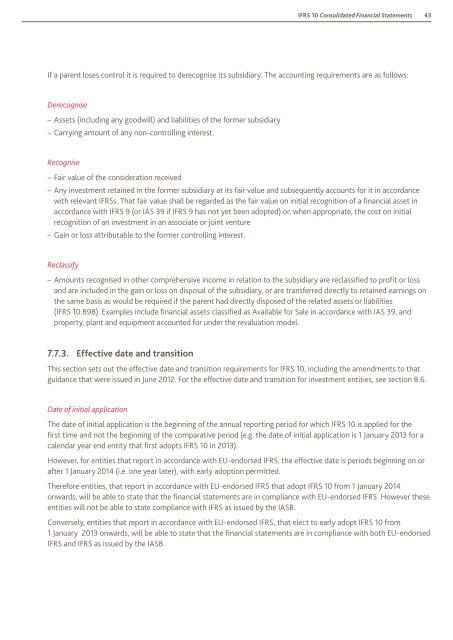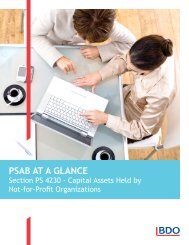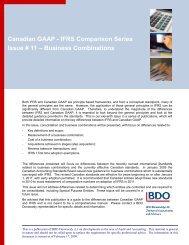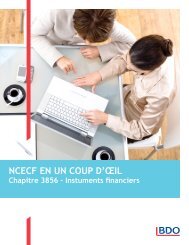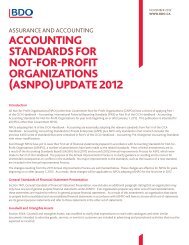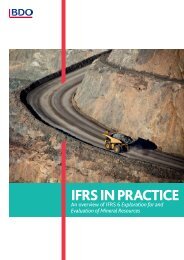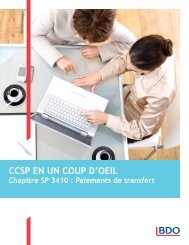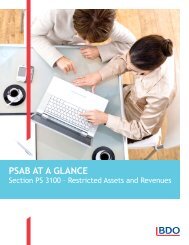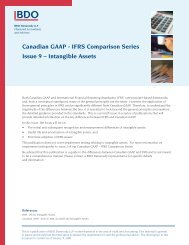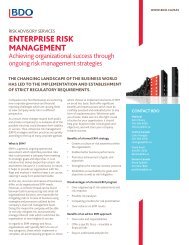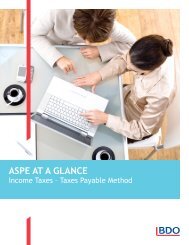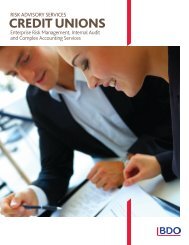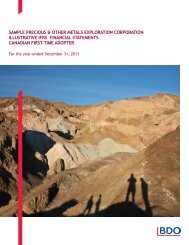Need to Know: IFRS 10 - Consolidated Financial ... - BDO Canada
Need to Know: IFRS 10 - Consolidated Financial ... - BDO Canada
Need to Know: IFRS 10 - Consolidated Financial ... - BDO Canada
- No tags were found...
Create successful ePaper yourself
Turn your PDF publications into a flip-book with our unique Google optimized e-Paper software.
<strong>IFRS</strong> <strong>10</strong> <strong>Consolidated</strong> <strong>Financial</strong> Statements43If a parent loses control it is required <strong>to</strong> derecognise its subsidiary. The accounting requirements are as follows:Derecognise––Assets (including any goodwill) and liabilities of the former subsidiary––Carrying amount of any non-controlling interest.Recognise––Fair value of the consideration received––Any investment retained in the former subsidiary at its fair value and subsequently accounts for it in accordancewith relevant <strong>IFRS</strong>s. That fair value shall be regarded as the fair value on initial recognition of a financial asset inaccordance with <strong>IFRS</strong> 9 (or IAS 39 if <strong>IFRS</strong> 9 has not yet been adopted) or, when appropriate, the cost on initialrecognition of an investment in an associate or joint venture––Gain or loss attributable <strong>to</strong> the former controlling interest.Reclassify––Amounts recognised in other comprehensive income in relation <strong>to</strong> the subsidiary are reclassified <strong>to</strong> profit or lossand are included in the gain or loss on disposal of the subsidiary, or are transferred directly <strong>to</strong> retained earnings onthe same basis as would be required if the parent had directly disposed of the related assets or liabilities(<strong>IFRS</strong> <strong>10</strong>.B98). Examples include financial assets classified as Available for Sale in accordance with IAS 39, andproperty, plant and equipment accounted for under the revaluation model.7.7.3. Effective date and transitionThis section sets out the effective date and transition requirements for <strong>IFRS</strong> <strong>10</strong>, including the amendments <strong>to</strong> thatguidance that were issued in June 2012. For the effective date and transition for investment entities, see section 8.6.Date of initial applicationThe date of initial application is the beginning of the annual reporting period for which <strong>IFRS</strong> <strong>10</strong> is applied for thefirst time and not the beginning of the comparative period (e.g. the date of initial application is 1 January 2013 for acalendar year end entity that first adopts <strong>IFRS</strong> <strong>10</strong> in 2013).However, for entities that report in accordance with EU-endorsed <strong>IFRS</strong>, the effective date is periods beginning on orafter 1 January 2014 (i.e. one year later), with early adoption permitted.Therefore entities, that report in accordance with EU-endorsed <strong>IFRS</strong> that adopt <strong>IFRS</strong> <strong>10</strong> from 1 January 2014onwards, will be able <strong>to</strong> state that the financial statements are in compliance with EU-endorsed <strong>IFRS</strong>. However theseentities will not be able <strong>to</strong> state compliance with <strong>IFRS</strong> as issued by the IASB.Conversely, entities that report in accordance with EU-endorsed <strong>IFRS</strong>, that elect <strong>to</strong> early adopt <strong>IFRS</strong> <strong>10</strong> from1 January 2013 onwards, will be able <strong>to</strong> state that the financial statements are in compliance with both EU-endorsed<strong>IFRS</strong> and <strong>IFRS</strong> as issued by the IASB.


